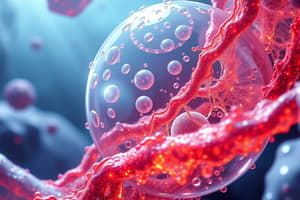Podcast
Questions and Answers
What is the purpose of the virtual lab experiment conducted by Miss Kroy?
What is the purpose of the virtual lab experiment conducted by Miss Kroy?
- To investigate the effect of water on the mass of different dialysis tubes
- To compare the mass of different beakers containing sugar solutions
- To observe changes in the mass of dialysis tubes submerged in sugar solutions (correct)
- To measure the water content in the beakers before and after adding sugar
What happened to the mass of dialysis tubes B and C after being submerged in sugar solutions?
What happened to the mass of dialysis tubes B and C after being submerged in sugar solutions?
- It fluctuated
- It decreased
- It increased (correct)
- It remained unchanged
Why was a control group of pure water used in the experiment?
Why was a control group of pure water used in the experiment?
- To compare the sugar concentrations in different beakers
- To measure the mass of dialysis tubes
- To standardize and provide a reference for comparison (correct)
- To determine if water had entered or exited the tubes
What can be inferred about the mass change of dialysis tube E?
What can be inferred about the mass change of dialysis tube E?
What was the outcome for tubes A and D after being submerged in sugar solutions?
What was the outcome for tubes A and D after being submerged in sugar solutions?
How does the cell respond to its external environment based on concentration differences?
How does the cell respond to its external environment based on concentration differences?
Study Notes
- Miss Kroy is conducting a virtual lab experiment to explore the effect of different sugar concentrations on a cell-represented dialysis tube.
- The experiment includes five beakers: A (control, no sugar), B (0% sugar), C (5% sugar), D (10% sugar), and E (15% sugar).
- Each beaker contains the same volume (1000 ml) of water.
- Sugar is added to beakers C, D, and E to create different sugar solutions.
- Participants measure and record the mass of each dialysis tube (representing the cell) before and after being submerged in the sugar solutions for 24 hours.
- The initial and final masses of each dialysis tube are compared to determine if water has entered or exited the tubes.
- The goal is to observe changes in the mass of the dialysis tubes to understand how the external sugar environment affects the cell (represented by the tube).- Two groups of dialysis tubes were weighed before and after a 24-hour period.
- Tubes B and C gained mass, suggesting water had entered them.
- Bag E lost a significant amount of weight, indicating water had left.
- A control group of pure water was used to provide a standard for comparison.
- Tubes A and D, which had identical sugar concentrations inside and outside, did not change mass.
- The cell responds to its external environment by allowing water to pass in or out based on concentration differences.
- When there's a greater concentration of solids outside the cell, water leaves, causing the mass of the dialysis tube to increase (hypertonic solution).
- Conversely, when there's a lower concentration of solids outside the cell, water enters, causing the mass of the dialysis tube to decrease (hypotonic solution).
- The concepts of hypotonic, isotonic, and hypertonic were used to describe the solutions, based on their relative sugar concentrations.
- Water flowed into or out of the tubing depending on the concentration gradient.
- Passive transport, the process at play, involves water moving from an area of high water concentration to an area of low water concentration, even if it goes against the sugar concentration gradient.
Studying That Suits You
Use AI to generate personalized quizzes and flashcards to suit your learning preferences.
Description
Explore the effect of different sugar concentrations on a cell-represented dialysis tube by conducting a virtual lab experiment. Understand how the external sugar environment affects the cell and observe changes in the mass of the dialysis tubes to determine the movement of water based on concentration differences.




